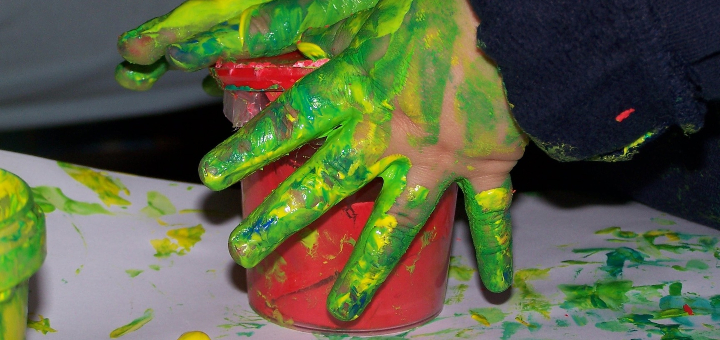
 Via Pixabay (2009), CC0 Public Domain[/caption]
Sitting in my family room is a poster-board sized piece of corrugated cardboard covered in toddler drawings -- shapes, mostly. At the top, in pink, it says "mommy" and "Leah" in letters clearly created by a preschooler. My daughter remembers this as our puzzle board -- the portable home for jigsaw puzzles in progress.
This is all well and good and warm and fuzzy. The problem? The toddler who created the board will turn twenty-one in November.
We unearthed this masterpiece when we moved a piece of furniture from our house to my dad's apartment. From a function perspective, it's not terribly useful (although I could use it as an excuse to pull out a jigsaw puzzle). From a storage perspective, it has no purpose whatsoever (it takes up space), and from a style perspective ... let's just say the memories outweigh the decorative value.
There is next to no logical reason for me to keep this, but I know I will. It's large but flat, and it won't be difficult to find a home for this, most likely behind another piece of furniture.
While my Type-A organizer friends are shaking their heads, I'm sure those with an I love stuff personal style completely understand.
We all have these items in our homes. There's no logical reason to keep them, but, on some level, they mean something to us, and so we find them homes. Is it okay to keep them?
That is entirely up to you. Here are a few questions to ask yourself when your head says "toss" and your heart says, "Nooooo!!!"
Is it hazardous, dangerous or otherwise a threat to physical or emotional safety? The piece of cardboard in question poses no physical danger to anyone and is completely harmless. An antique firearm, on the other hand, might be less welcome. As far as emotional safety goes, I feel a sweet sense of nostalgia when I look at the big blobs of multi-colored shapes, and am transported back to long summer days and puzzle races. I like those feelings and memories. On the other hand, a similar item that conjures up sadness and regret has probably outlived its usefulness. In that case, listen to your head. Dispose of it.
Does it take up more than its fair share of space? Storage-wise, there's a huge difference between keeping a piece of preschool artwork and, say, a middle school plaster sculpture that's abstract (i.e. you're not sure what it's supposed to be). If it's easy enough to tuck the item away somewhere, honor your heart. If you need to make space for it, are tripping over it, and your child doesn't remember making it in the first place, listen to your head.
Does it have meaning for anyone else? As noted above, when I see this decorated piece of cardboard, I immediately remember the small child who created it. No matter how big and mature she is now, she's immediately 3 1/2 in my mind with just one glance at this silly memento. I can still reason my way out of this, though, citing plenty of other things (photographs, for example) that conjure up these images. But, when the twenty-year-old identified it as "our puzzle board," my head didn't stand a chance. It was heart all the way.
Preserving the tenuous balance between possessions and the amount of available space in our homes is an important part of the organization process. But, we are human, after all, and sometimes it's not as simple as form, function and style. Hanging on to a few things (in moderation) because our hearts can't let go can add a little pizzazz to our styles.
So stash it, frame it, display it, or put it in a "maybe" box to deal with later. Celebrate the things that have meaning to you, and don't assume that the head is always a better decision-maker than the heart.
Via Pixabay (2009), CC0 Public Domain[/caption]
Sitting in my family room is a poster-board sized piece of corrugated cardboard covered in toddler drawings -- shapes, mostly. At the top, in pink, it says "mommy" and "Leah" in letters clearly created by a preschooler. My daughter remembers this as our puzzle board -- the portable home for jigsaw puzzles in progress.
This is all well and good and warm and fuzzy. The problem? The toddler who created the board will turn twenty-one in November.
We unearthed this masterpiece when we moved a piece of furniture from our house to my dad's apartment. From a function perspective, it's not terribly useful (although I could use it as an excuse to pull out a jigsaw puzzle). From a storage perspective, it has no purpose whatsoever (it takes up space), and from a style perspective ... let's just say the memories outweigh the decorative value.
There is next to no logical reason for me to keep this, but I know I will. It's large but flat, and it won't be difficult to find a home for this, most likely behind another piece of furniture.
While my Type-A organizer friends are shaking their heads, I'm sure those with an I love stuff personal style completely understand.
We all have these items in our homes. There's no logical reason to keep them, but, on some level, they mean something to us, and so we find them homes. Is it okay to keep them?
That is entirely up to you. Here are a few questions to ask yourself when your head says "toss" and your heart says, "Nooooo!!!"
Is it hazardous, dangerous or otherwise a threat to physical or emotional safety? The piece of cardboard in question poses no physical danger to anyone and is completely harmless. An antique firearm, on the other hand, might be less welcome. As far as emotional safety goes, I feel a sweet sense of nostalgia when I look at the big blobs of multi-colored shapes, and am transported back to long summer days and puzzle races. I like those feelings and memories. On the other hand, a similar item that conjures up sadness and regret has probably outlived its usefulness. In that case, listen to your head. Dispose of it.
Does it take up more than its fair share of space? Storage-wise, there's a huge difference between keeping a piece of preschool artwork and, say, a middle school plaster sculpture that's abstract (i.e. you're not sure what it's supposed to be). If it's easy enough to tuck the item away somewhere, honor your heart. If you need to make space for it, are tripping over it, and your child doesn't remember making it in the first place, listen to your head.
Does it have meaning for anyone else? As noted above, when I see this decorated piece of cardboard, I immediately remember the small child who created it. No matter how big and mature she is now, she's immediately 3 1/2 in my mind with just one glance at this silly memento. I can still reason my way out of this, though, citing plenty of other things (photographs, for example) that conjure up these images. But, when the twenty-year-old identified it as "our puzzle board," my head didn't stand a chance. It was heart all the way.
Preserving the tenuous balance between possessions and the amount of available space in our homes is an important part of the organization process. But, we are human, after all, and sometimes it's not as simple as form, function and style. Hanging on to a few things (in moderation) because our hearts can't let go can add a little pizzazz to our styles.
So stash it, frame it, display it, or put it in a "maybe" box to deal with later. Celebrate the things that have meaning to you, and don't assume that the head is always a better decision-maker than the heart.

Copyright 2018 Lisa Hess
About the Author

Lisa Hess
Transplanted Jersey girl Lisa Lawmaster Hess is the author of a blog compilation, three novels, and three non-fiction books, including the award-winning Know Thyself: The Imperfectionist’s Guide to Sorting Your Stuff. A retired elementary school counselor, Lisa is an adjunct professor of psychology at York College of Pennsylvania. She blogs at The Porch Swing Chronicles, Organizing by STYLE, and here at Catholicmom.com. Read all articles by Lisa Hess.


.png?width=1806&height=731&name=CatholicMom_hcfm_logo1_pos_871c_2728c%20(002).png)
Comments